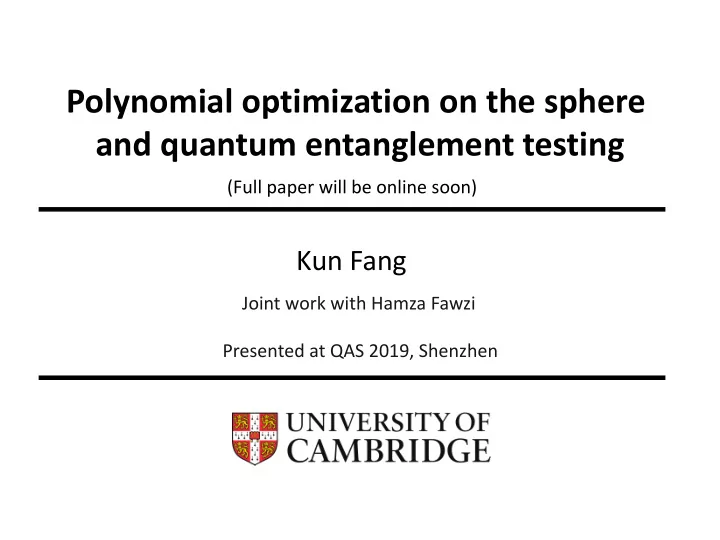

Polynomial optimization on the sphere and quantum entanglement testing (Full paper will be online soon) Kun Fang Joint work with Hamza Fawzi Presented at QAS 2019, Shenzhen
Talk Outline ◎ Polynomial Optimization and SOS Hierarchy ◎ An improved Convergence Rate Main Result and Proof Strategy ◎ Relation to Entanglement Testing SOS Hierarchy (polynomial) v.s. DPS Hierarchy (quantum) ◎ Summary and Discussions
Polynomial Optimization on the Sphere
<latexit sha1_base64="(nul)">(nul)</latexit> <latexit sha1_base64="(nul)">(nul)</latexit> <latexit sha1_base64="(nul)">(nul)</latexit> <latexit sha1_base64="(nul)">(nul)</latexit> <latexit sha1_base64="(nul)">(nul)</latexit> <latexit sha1_base64="(nul)">(nul)</latexit> <latexit sha1_base64="(nul)">(nul)</latexit> <latexit sha1_base64="(nul)">(nul)</latexit> <latexit sha1_base64="(nul)">(nul)</latexit> <latexit sha1_base64="(nul)">(nul)</latexit> <latexit sha1_base64="(nul)">(nul)</latexit> <latexit sha1_base64="(nul)">(nul)</latexit> <latexit sha1_base64="(nul)">(nul)</latexit> <latexit sha1_base64="(nul)">(nul)</latexit> <latexit sha1_base64="(nul)">(nul)</latexit> <latexit sha1_base64="(nul)">(nul)</latexit> <latexit sha1_base64="(nul)">(nul)</latexit> <latexit sha1_base64="(nul)">(nul)</latexit> <latexit sha1_base64="(nul)">(nul)</latexit> <latexit sha1_base64="(nul)">(nul)</latexit> Polynomial Optimization on the Sphere Q Given a multivariate polynomial with p ( x ) x = ( x 1 , · · · , x d ) Computing the maximal value p max = max x ∈ S d − 1 p ( x ) Over the unit sphere S d − 1 = x ∈ R d : x 2 � 1 + · · · + x 2 d = 1 Applications: o the largest stable/independent set of a graph o Degree 3 polynomial opt. on the sphere (e.g. [Nesterov’03, De Klerk’08]) o 2 → 4 norm of a matrix A, p ( x ) = k Ax k 4 4 o Degree 4 polynomial opt. on the sphere (e.g. [Barak et al.’12]) o Best Separable State problem in quantum information theory o Degree 4 polynomial opt. on the product of spheres (e.g. [Barak-Kothari-Steurer’17]) o …
<latexit sha1_base64="(nul)">(nul)</latexit> <latexit sha1_base64="(nul)">(nul)</latexit> <latexit sha1_base64="(nul)">(nul)</latexit> <latexit sha1_base64="(nul)">(nul)</latexit> <latexit sha1_base64="(nul)">(nul)</latexit> <latexit sha1_base64="(nul)">(nul)</latexit> <latexit sha1_base64="(nul)">(nul)</latexit> <latexit sha1_base64="(nul)">(nul)</latexit> <latexit sha1_base64="(nul)">(nul)</latexit> <latexit sha1_base64="(nul)">(nul)</latexit> <latexit sha1_base64="(nul)">(nul)</latexit> <latexit sha1_base64="(nul)">(nul)</latexit> <latexit sha1_base64="(nul)">(nul)</latexit> <latexit sha1_base64="(nul)">(nul)</latexit> <latexit sha1_base64="(nul)">(nul)</latexit> <latexit sha1_base64="(nul)">(nul)</latexit> Polynomial Optimization on the Sphere Q Given a multivariate polynomial with p ( x ) x = ( x 1 , · · · , x d ) Computing the maximal value p max = max x ∈ S d − 1 p ( x ) Over the unit sphere S d − 1 = x ∈ R d : x 2 � 1 + · · · + x 2 d = 1 Difficulty: o Degree = 2, efficiently solved as an eigenvalue problem; o Degree > 2, NP-hard in general! Solution: o Sum-of-square (SOS) hierarchy [Parrilo’00; Lasserre’01] where each level is efficiently computable by semidefinite program
Recommend
More recommend